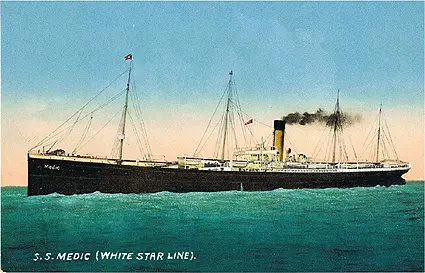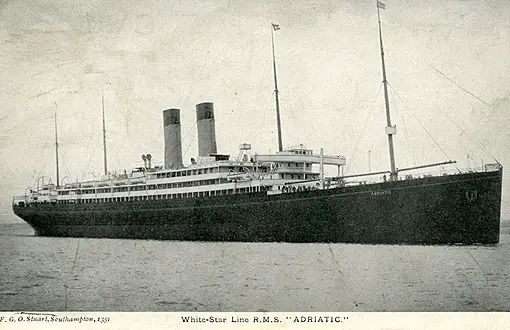3. White Star Line
For unknown reasons, Murdoch's first White Star assignment, the Medic on the Australia route, is missing from his file in Lloyd's Captains' Register, but he sailed in her alternately with the Runic, beginning in 1900 and possibly earlier. He had served in troop ships en route to the Boer War, which may partially explain the lapses in Lloyd's entries.
The Oceanic Steam Navigation Company, Ltd. (White Star was a trade name) owned freighters and a fleet of ever larger, more elegant and more luxurious passenger liners. The cargo service was occasionally discontinued for financial reasons; in 1893 the freighter Naronic would disappear at sea, perhaps from collision with an iceberg, but possibly from collision with the Rosseau. The passenger fleet, however, constructed exclusively by Harland & Wolff in Belfast, would have few equals and only one British rival, the British and North American Royal Mail Steam Packet Company, better known as Cunard. Lucius Beebe, who was born into Gilded Age society and in a position to know, shrewdly pointed out that when the Lusitania was torpedoed in 1915 outrage in the United States was directed not at the loss of life but at the loss of the ship. The great liners stood for civilized life, for something beyond the hard, circumscribed, crude existence that was all most people would ever have, for beauty and glamour and, above all, for hope. In the seemingly endless progression of bigger, safer, more comfortable ships there appeared to be proof that technology combined with money made miracles.

Postcard of the SS Medic. (Click image to enlarge)
To be accepted as an officer with one of the great passenger companies was an ambition of many of the brightest sail trained sailors who could produce, as William Murdoch could, all required certificates and impeccable references from masters and owners. The chance to serve, and ultimately to command, one of White Star's exquisite passenger ships was a glittering, promising goal, and with it went another much prized possession: a Lieutenant's commission in the Royal Navy Reserve. White Star obliged its officers to join the Reserve, which meant, of course, being acceptable to the Royal Navy as well as company headquarters in Liverpool.
It is difficult in the closing years of the 20th Century to appreciate just how much prestige a commission in the Royal Navy conveyed in the last years of Queen Victoria's reign. Two world conflicts and a progression of emergencies in awkward places have demonstrated that time and the end of Empire have in no way diminished the grandeur or resourcefulness of the Navy. But when William Murdoch was commissioned as one of Queen Victoria's officers there was no Royal Air Force to compete for funds or glory and the Army seemed always to be getting itself shot up in unpronounceable colonial hell holes. The fleet of the Queen's last years was still the recognizable heir of Admiral Alfred Thayer Mahan's "far off storm beaten ships" that had enraged Napoleon, and its glorious new dreadnoughts were as thrilling to behold as they were reassuring to British nerves. In 1900, the ancient standing order of the Admiralty was still perfectly true: "It is upon the Navy, under the good providence of God, that the wealth, safety, and strength of the Kingdom do chiefly depend."
Both the Kirkcudbrightshire Advertizer and the Dumfries and Galloway Standard and Advertizer (local newspapers near Dalbeattie) would refer to William Murdoch in their coverage of the Titanic as Lieutenant Murdoch, as did the Daily Telegraph, and the Scotsman pointedly referred to his naval rank. The usage was not confined to the press: Mr. Gilfeather, plumber by trade, used the title when bringing up Murdoch's name at a public meeting in Dumfries on April 29, 1912, and the town meeting at Dalbeattie on August 11, 1912, out of which the memorials would come, made sure that the title and the initials R.N.R were included on the Town Hall Memorial tablet. It was a very grand thing in 1912 to hold the King's commission, and with it went some very grand responsibilities professional, cultural and moral. It must be borne in mind when appraising William Murdoch's actions in those last hours that there really are things worse than death, and in 1912 one of them for a British officer placed in command would be to survive a debacle like the Titanic and then explain it to the King.

William Murdoch served aboard the Adriatic from April 1907 - 23rd May 1911.
(Click image to enlarge)
Murdoch's rise in White Star's service was rapid and spectacular; he generally served as either Chief Officer or First Officer, and was within a few years transferred from the Australian service to the prestigious North Atlantic route, on the new Arabic, Liverpool to New York, June 25, 1903. From the Arabic he moved to the Celtic, on January 30, 1904, and remained on her until sent to the Germanic on September 2, 1904, for two trips. As of January 28, 1905, Murdoch was assigned to the Oceanic, where he served for all of 1905 and 1906, except for two voyages on the Cedric, February 14, 1906, and March 10, 1906. Sometime prior to May 6, 1907, he was appointed First Officer of the new Adriatic, where he remained until assigned to the Olympic in June of 1911, as her First Officer (In the strange manner of such survivals, Murdoch's copy of company regulations from the Adriatic still exists, and has been published by the Oceanic Navigation Research Society, in California). From thence, in March of 1912, Murdoch was transferred by the White Star Line for the last time, to the Titanic.
